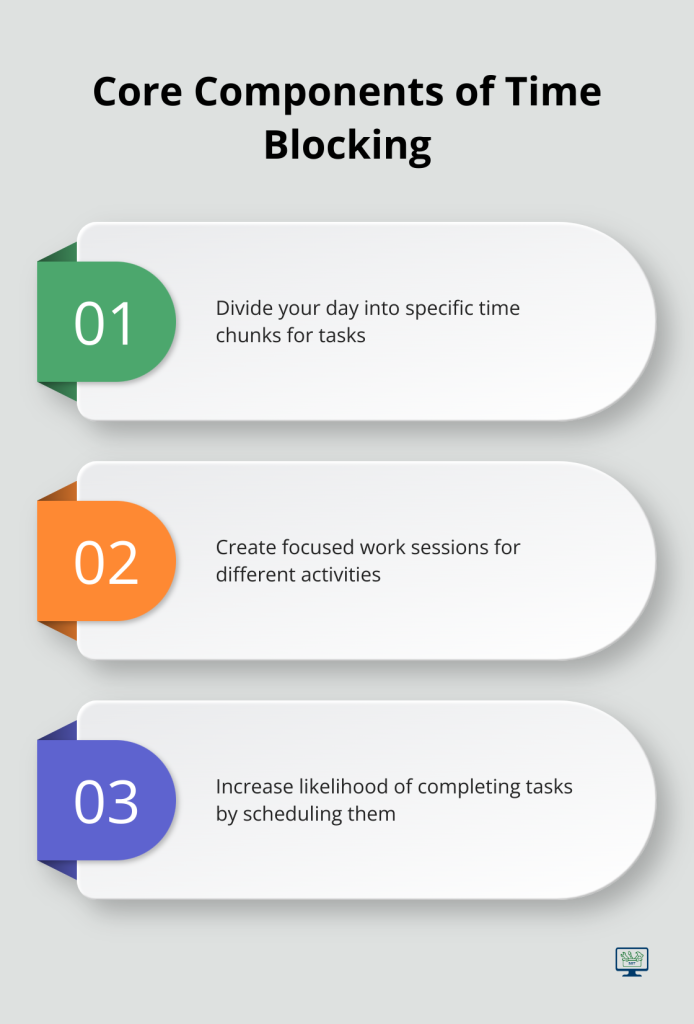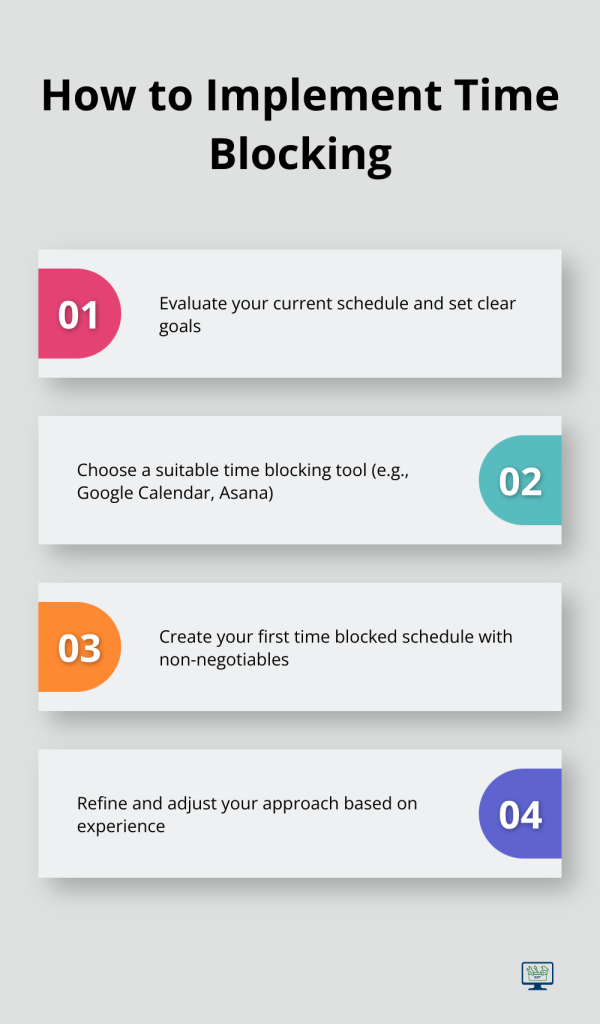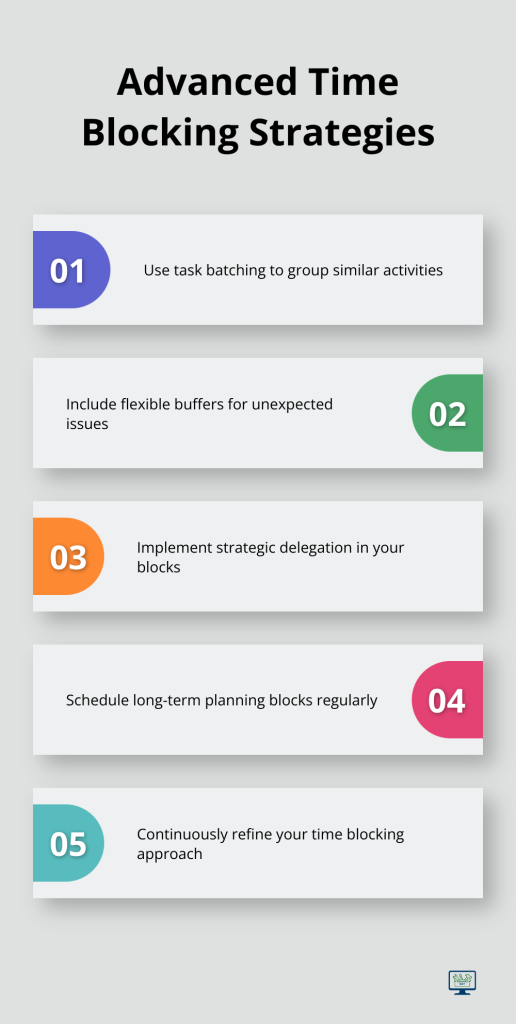Time blocking is a powerful technique that can transform how entrepreneurs manage their day. At SmallBizToolbox, we’ve seen firsthand how this method helps business owners boost productivity and achieve their goals.
In this guide, we’ll show you how to master time blocking and apply it to your entrepreneurial journey. Get ready to take control of your schedule and supercharge your business growth.
What Is Time Blocking?
The Essence of Time Blocking
Time blocking transforms how entrepreneurs work by dividing your day into specific chunks of time, each dedicated to a particular task or group of tasks. At its core, time blocking emphasizes intentionality and focus.
Creating Focused Work Sessions
Time blocking essentially involves creating appointments with yourself for different activities. You might set aside time for client calls, email management, and deep work on major projects. The key is to adhere to these blocks as if they were meetings with your most important client – yourself.
The Entrepreneur’s Need for Time Blocking
For business owners, time often represents the most precious resource. Time blocking helps you take control of your schedule instead of letting it control you. When you assign specific times to your to-do list, you increase the likelihood of actually completing those items.
Time Blocking vs. Other Techniques
While to-do lists are a staple for many, they often fall short in execution. Time blocking takes those lists a step further by assigning each task a place in your day. Unlike the Pomodoro Technique (which uses fixed time intervals), time blocking allows for flexibility in block duration based on the task at hand.
Time boxing, a close cousin of time blocking, sets strict time limits for tasks. While effective for some, many entrepreneurs find the rigid structure of time boxing too constraining for their dynamic workdays. Time blocking offers a balance – structure with flexibility.
The Impact on Productivity
Time blocking can significantly boost efficiency and reduce the stress of constantly deciding what to do next. Pre-deciding your day’s structure frees up mental energy for the actual work at hand.
As we move forward, let’s explore how to implement time blocking effectively in your entrepreneurial journey.

How to Implement Time Blocking
Time blocking transforms how entrepreneurs manage their time, but its effective implementation requires a strategic approach. This chapter outlines practical steps to make time blocking work for your business.
Evaluate Your Current Schedule
Before you start time blocking, analyze how you spend your time. Set clear goals like launching a new product or increasing sales by 20% within six months. This helps prioritize tasks that align with your objectives. For one week, track every task you complete and its duration. This exercise often reveals surprising insights. You might uncover hours spent on low-value activities or tasks that take longer than anticipated.
Use this data to identify your most productive hours and the tasks that consume too much of your day. This information will prove invaluable when you create your time blocks.
Choose Your Time Blocking Tool
While a simple paper planner suffices, digital tools often offer more flexibility and features. Google Calendar (a popular free option) allows you to color-code different types of tasks. For more advanced features, consider tools like Asana or Trello, which combine task management with scheduling capabilities.
Many Australian entrepreneurs prefer digital solutions that integrate with their existing workflow. Select a tool you’ll use consistently. If you use Trello or Jira as your to-do list or project management tool, Planyway lets you block time on your calendar using those tasks.
Create Your First Time Blocked Schedule
Now comes the exciting part – creating your first time blocked schedule. Start by blocking out your non-negotiable commitments (meetings and deadlines). Then, allocate time for your most important tasks during your peak productivity hours.
Group similar tasks together to minimize context switching. For example, you might block out 9-10 AM for email and communication, 10 AM-12 PM for focused work on your top priority project, and 1-2 PM for administrative tasks.
Don’t forget to schedule breaks and buffer time between blocks. This flexibility proves essential for dealing with unexpected issues that inevitably arise in business.
Refine and Adjust
Your first attempt at time blocking won’t be perfect (and that’s okay). The key is to start and then refine your approach. After a week, assess what worked and what didn’t. Did your time estimates prove accurate? Did you stick to your blocks? Use these insights to adjust your schedule for the following week.
Time blocking improves with practice. Be patient with yourself as you develop this new habit. Many entrepreneurs find that it takes about a month of consistent use before time blocking feels natural and truly effective.
As you master these fundamental strategies, you’ll boost your productivity as an entrepreneur. The next section explores advanced time blocking techniques to elevate your efficiency even further.

Elevate Your Time Blocking Game
Task Batching for Efficiency
Group similar tasks to minimize context switching and boost efficiency. Dedicate blocks to specific activities like client calls or financial tasks. This approach reduces the mental load of shifting between different types of work. Task batching helps reduce the amount of context switching you have to do during the day. Instead of tackling your to-dos as they come, the task batching method encourages you to group similar tasks together.
Flexible Buffers for Reality
Entrepreneurial life is unpredictable. Build buffer time into your schedule to accommodate unexpected issues or tasks that run long. Leave 20% of your day unscheduled as a good rule of thumb. This flexibility allows you to handle surprises without derailing your entire day. It also reduces stress, as you’re not constantly falling behind schedule.
Strategic Delegation in Blocks
Use your time blocks to identify tasks you can delegate or outsource. As you review your schedule, ask yourself: “Is this the best use of my time? Could someone else handle this task?” According to a report by the Australian Outsourcing Association, small businesses that outsource non-core functions can save up to 30% on labor costs. Connect with skilled freelancers to take on these tasks and focus on what truly matters for your business growth.
Long-Term Planning Blocks
Don’t limit your focus to day-to-day tasks. Schedule regular blocks for long-term business planning. This might include a weekly 2-hour block to review progress on quarterly goals or a monthly half-day session to strategize for the coming quarter. These focused planning sessions ensure you work on your business, not just in it. Strategic planning and its goals are crucial for an organization’s success.
Continuous Refinement
Implement these advanced time blocking strategies with patience and persistence. The payoff is substantial: you’ll accomplish more, with less stress and greater clarity on your business direction. Keep iterating and adjusting your time blocks to fit your evolving business needs. The goal is progress, not perfection.

Final Thoughts
Time blocking transforms how entrepreneurs manage their day. This powerful technique divides your schedule into focused blocks, ensuring important tasks receive proper attention. You can start small by blocking out a few hours each day, then expand as you become more comfortable with the method.
SmallBizToolbox supports Australian entrepreneurs in their business growth journey. We offer a range of tools and resources, from AI-driven content creation to SEO optimization. Our platform helps you enhance your time management and overall business strategy.
Take the first step towards mastering time blocking today. Evaluate your current schedule, identify your most important tasks, and create a simple time blocked schedule for tomorrow. Explore our offerings and take advantage of our free 7-day trial to see how we can help you boost your productivity.
How useful was this Resource?
Click on a star to rate it!
Average rating 0 / 5. Vote count: 0
No votes so far! Be the first to rate this post.
We are sorry that this post was not useful for you!
Let us improve this Resource!
Tell us how we can improve this Resource?




